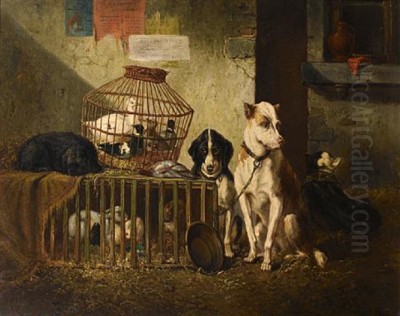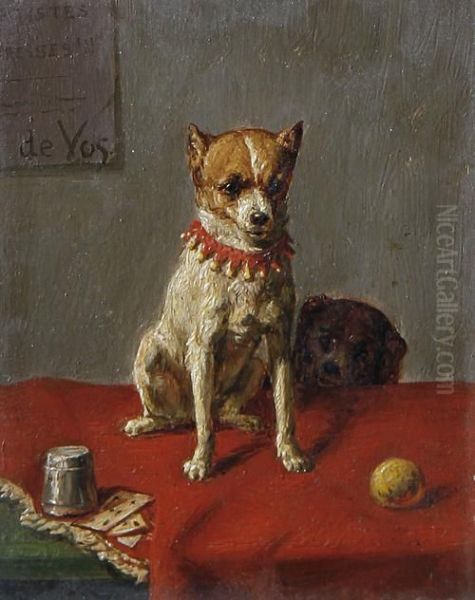
Vincent de Vos stands as a notable figure in nineteenth-century Belgian art, celebrated primarily for his engaging and meticulously rendered paintings of animals. Born Josse Vincent de Vos in Kortrijk (Courtrai), Belgium, in 1829, he carved a distinct niche for himself within the broader currents of European Realism. His work, often imbued with gentle humour and narrative charm, focused particularly on dogs and monkeys, capturing their forms and perceived personalities with remarkable skill and sensitivity. De Vos passed away in his hometown of Kortrijk in 1875, leaving behind a body of work that continues to appeal to collectors and enthusiasts of animal portraiture.
Early Life and Artistic Formation in Kortrijk
Vincent de Vos's artistic journey began in his native West Flanders city of Kortrijk. This region, with its rich artistic heritage, provided the backdrop for his formative years. He received his formal art education at the local academy, an institution that nurtured the talents of many regional artists. A pivotal figure in his training was the established animal painter Edouard Woutermaertens (sometimes spelled Wauters or Wautermaertens), under whom De Vos honed his skills. Woutermaertens' own focus on animal subjects undoubtedly influenced the young De Vos, guiding him towards the specialization that would define his career. This grounding in academic drawing and painting, combined with a specific focus on animal anatomy and behaviour, laid the foundation for his future success.
The Signature Style: Realism, Detail, and Anthropomorphism
De Vos developed a style characterized by careful observation and precise execution, aligning with the Realist tendencies prevalent in the mid-nineteenth century. He excelled at rendering the textures of fur, the moistness of a dog's nose, or the intelligent gaze in an animal's eyes. His compositions are typically well-structured, placing his animal subjects in believable, often domestic or stable-like, settings. While fundamentally realistic, his work often incorporates elements of anthropomorphism, particularly in his depictions of monkeys.

He became particularly known for his contributions to the singerie genre – humorous scenes depicting monkeys dressed in human clothing and engaging in human activities. These works, showcasing monkeys as jockeys, drinkers, or scholars, allowed De Vos to display not only his technical prowess but also a playful wit. This genre had a long history, dating back to Flemish artists like David Teniers the Younger in the 17th century, but De Vos revitalized it with his detailed, nineteenth-century sensibility. His dog portraits, often featuring breeds like King Charles Cavaliers, greyhounds, and terriers, were equally popular, capturing moments of quiet repose, alertness, or interaction between different animals.
A significant, though perhaps indirect, influence on De Vos, as on many animal painters of the era, may have been the work of the highly successful British artist Sir Edwin Landseer. Landseer's ability to imbue animal subjects with narrative weight and emotional depth resonated across Europe, and echoes of his approach to animal psychology can sometimes be discerned in De Vos's careful attention to expression and posture. However, De Vos maintained his own distinct Flemish flavour, rooted in detailed observation and often a lighter, more anecdotal touch than Landseer's sometimes grander dramas.
Representative Works and Thematic Focus
Among Vincent de Vos's most characteristic and celebrated works is a painting often titled A Jockey (Monkey), His Horse (Greyhound) and a King Charles Cavalier. This piece perfectly encapsulates his skill and thematic interests. It depicts a monkey, dressed in jockey silks, perched atop a patient greyhound, while a small King Charles Spaniel looks on. The scene is rendered with meticulous attention to detail, from the textures of the animals' fur and the sheen of the jockey's cap to the carefully delineated background elements like a basket and a patterned rug. The work combines technical skill, a humorous singerie concept, and an evident affection for the animals portrayed.
Beyond the overtly humorous singeries, De Vos produced numerous paintings focusing solely on dogs. These often depict terriers, spaniels, or hounds, sometimes singly, sometimes in groups, often within interior settings like studies or near fireplaces, or in outdoor environments suggesting hunting or leisure. Works like Terrier Guarding Fowl or portraits simply titled Study of a Dog showcase his ability to capture the unique character and physical presence of different breeds. He masterfully conveyed the alert intelligence of a terrier, the gentle nature of a spaniel, or the sleek lines of a greyhound. These works appealed greatly to the tastes of the nineteenth-century bourgeoisie, who increasingly kept dogs as pets and appreciated realistic portrayals of their companions.
While less documented, his repertoire likely included other domestic animals as well, consistent with the broader tradition of animal painting in the Low Countries. The recurring themes in his known oeuvre, however, remain the intimate portrayal of dogs and the playful, anthropomorphic depiction of monkeys, often highlighting interactions between different species.
Career, Exhibitions, and Recognition
Vincent de Vos achieved considerable recognition during his lifetime, exhibiting his works not only in his native Belgium but also internationally. His paintings were shown in prominent salons and galleries in France, Italy, and even the United States. This international exposure speaks to the universal appeal of his subject matter and the quality of his execution. Museums acquired his works, ensuring their presence in public collections. Notably, institutions in French cities like Lille, Tourcoing, and Mulhouse hold examples of his paintings. The presence of his work in these collections underscores his standing within the Franco-Belgian art scene of the period.
Unlike some of his contemporaries who became associated with specific artistic movements or manifestos, De Vos appears to have operated primarily as an individual artist focused on his chosen specialty. While his work aligns broadly with Realism, there is no indication he was formally part of groups like the Société Libre des Beaux-Arts in Brussels, which championed progressive trends. His success seems to have been built on the consistent quality of his output and the popularity of his animal themes, rather than alignment with a particular avant-garde faction. He catered to a market that appreciated skillful representation and charming, relatable subjects.
Vincent de Vos in the Context of 19th-Century Belgian Art
To fully appreciate Vincent de Vos's contribution, it's helpful to place him within the context of Belgian art during the mid-nineteenth century. Belgium, having gained independence in 1830, was forging its national identity, and art played a role in this process. The period saw a flourishing of various styles, from lingering Romanticism, particularly in historical painting led by figures like Louis Gallait and Hendrik Leys (the latter evolving towards a form of historical realism), to the burgeoning Realist movement.
Realism in Belgium took various forms. Constantin Meunier would become famous for his depictions of industrial labourers, while Charles Degroux focused on scenes of peasant life and social commentary. Henri de Braekeleer, working in Antwerp, developed a highly personal, intimate style of genre painting, focusing on interiors rendered with meticulous detail and sensitivity to light, somewhat parallel to De Vos's attention to detail in a different subject area.
Animal painting itself was a well-established and popular genre in Belgium. Eugène Verboeckhoven was an immensely successful, slightly earlier contemporary known for his idealized depictions of livestock, particularly sheep, rendered with smooth precision. Compared to Verboeckhoven's often pastoral and somewhat formulaic approach, De Vos offered a more intimate and sometimes humorous perspective, particularly with his focus on domestic pets and singeries. Another important Belgian artist associated with animals was Joseph Stevens, known for his powerful, unsentimental depictions of dogs, often stray or working animals in urban settings, which carried a stronger social realist edge than De Vos's work. Joseph's brother, Alfred Stevens, achieved international fame primarily for his elegant paintings of fashionable women in luxurious interiors, but his commitment to realistic observation connects him to the broader movement.
Internationally, De Vos's specialization can be seen alongside the work of other prominent animal painters. Besides the aforementioned Sir Edwin Landseer in Britain, Rosa Bonheur in France gained widespread acclaim for her large-scale, vigorous paintings of animals, such as The Horse Fair. While De Vos's scale and perhaps ambition were generally more modest, he shared with these artists a deep engagement with animal life and a commitment to representing it convincingly. The broader European context was also shaped by the powerful influence of French Realism, spearheaded by Gustave Courbet, whose insistence on depicting contemporary life and observable reality set the stage for artists like De Vos, even if their subject matter and tone differed. De Vos's teacher, Edouard Woutermaertens, also belongs in this context as a practitioner who passed on the tradition of careful animal depiction within their shared Kortrijk environment. Other Belgian artists like Jean Robie, known for his still lifes often incorporating animals, or Alfred Verwée, specializing in landscapes with cattle, further illustrate the diversity within Belgian Realism and related genres during De Vos's active period.
Legacy and Auction Presence
Vincent de Vos's legacy lies primarily in his contribution to the genre of animal painting in Belgium. He successfully combined academic technique with popular subject matter, creating works that were both skillfully executed and widely appealing. His singeries, in particular, represent a charming continuation and adaptation of an older Flemish tradition. While perhaps not a major innovator who drastically changed the course of art history, he was a highly competent and engaging painter within his chosen field. His works remain appreciated for their detail, characterization, and the glimpse they offer into nineteenth-century tastes and the relationship between humans and domestic animals.
His paintings continue to appear on the art market, finding buyers among collectors of nineteenth-century European art and specialists in animal painting. Auction records show his works appearing at various houses, sometimes fetching modest sums, as indicated by an estimate of $400-$500 at a Case Antiques auction, while other works, depending on size, quality, and subject, can achieve higher prices. For instance, a panel painting titled Hond, kip en haan Olie op paneel (Dog, chicken and rooster, oil on panel) was listed for auction at Van Wiele Vellingen in the Netherlands in August 2024. This ongoing market presence demonstrates a sustained interest in his work, nearly 150 years after his death.
Conclusion: An Enduring Appeal
Josse Vincent de Vos was a quintessential nineteenth-century specialist painter. Working within the realist tradition prevalent in Belgium and across Europe, he dedicated his career to the depiction of animals, particularly dogs and monkeys. His education at the Kortrijk Academy and tutelage under Edouard Woutermaertens provided him with a solid technical foundation, which he applied to subjects that charmed his contemporaries and continue to engage viewers today. His detailed renderings, his participation in the singerie tradition, and his ability to capture the perceived character of his animal subjects define his artistic identity. Though perhaps overshadowed by Belgian artists with grander historical or social themes, like Gallait or Meunier, or by international stars of animal painting like Landseer or Bonheur, Vincent de Vos holds a secure place as a master of his specific craft. His paintings, found in museums like those in Lille and Tourcoing and periodically surfacing at auction, remain as testaments to his skill and the enduring appeal of well-painted animals.